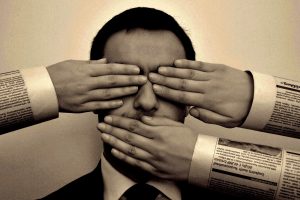
What is the state of media freedom in India? With constant censorship from both state and non-state actors, as of now it is obvious that journalists in this country are enduring terrible times only to practice the profession. At the same time, with giant corporates and close aids of political leaders owning and controlling large sections of media houses, news, influenced by them, is being circulated in the mainstream media, which reaches the majority people.
However, there are journalists who strive for critical journalism but at the cost of death threats and legal cases. The latest report by the Hoot, titled Media Freedom and Freedom of Expression in 2017 , reveals the adverse climate of journalism in India. India ranked 136 among 180 countries in World Press Freedom Index in 2017. As per the report, last year, 11 journalists murdered, 46 attacked, 27 booked in police cases and 12 threatened for reporting.
The major perpetrators, according to the report are the police officials, politicians and political workers, followed by right-wing activists and other non- state actors.
The following are the significant points put out in the report on the instances – murders, threats, attacks, censorship, self-censorship, internet shutdowns and hate speech.
- Sikkim is the most trouble state and Kashmir, most unfree state, measured by the yardstick of free speech and media freedom.
- Two journalists were shot at point-blank range and killed, and one was hacked to death by a mob as police stood by. One murder, that of Gauri Lankesh, editor of the Kannada publication Gauri Lankesh Patrike took place in Karnataka and two others in Tripura.
- Ugly and murderous threats increasingly targeted the media.
- There were 13 cases of journalists being interrogated and let off, or arrested, or have cases registered against them. Chhattisgarh alone recorded 13 police actions against journalists.
- In June, in Karnataka, the speaker of the legislative assembly and head of the house of privileges committee, K.B. Koliwad, sentenced editors of two local weeklies to one year in jail and imposed a fine of Rs. 10,000 each for publishing alleged defamatory articles about legislators.
- In July, the Economic and Political Weekly editor Paranjoy Guha Thakurta quit his job when he was asked to take-down an already published investigation relating to Adani Power by the journal board.
- At the end of the year, when a Caravan story on the 2014 death of Justice B H Loya, the judge handling the Sohrabuddin case, made waves, there was a deafening silence from other media houses, notably on channels such as Times Now and Republic TV.
- Kashmir had 40 internet shutdowns against 77 recorded for the entire country.
- Maharashtra had the highest incidence of defamation and Andhra Pradesh the largest number of attacks on and threats to journalists.
- Karnataka had the highest number of state actions for internet and social media-related incidents.
- Maharashtra emerged as the defamation capital of the country, recording 19 cases. While in Tamil Nadu, the number of defamation cases has come down sharply following Jayalalitha’s demise in December 2016.
-
Ten out of 16 hate speech cases registered were against BJP politicians and party members or against right-wing groups such as the All India Hindu Sangathi Manch and the Hindu Jagarana Vedike.




